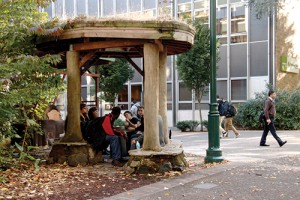It’s happening all over Oregon.
In 2009, Portland Community College became a tobacco-free campus.
On Sept. 1, Oregon State University and the University of Oregon also became smoke-free.
It’s happening all over Oregon.
In 2009, Portland Community College became a tobacco-free campus.
On Sept. 1, Oregon State University and the University of Oregon also became smoke-free.
It’s happening all over Oregon.
In 2009, Portland Community College became a tobacco-free campus.

COURTESY OF pdx.edu
The shaded area from Lincoln Hall to Shattuck Hall is the new Clean Air Corridor. The smoke-free zone goes into effect Jan. 1 and will include a ban on idling vechicles, leaf blowers and small utility vehicles.
On Sept. 1, Oregon State University and the University of Oregon also became smoke-free.
Starting Jan. 1, 2013 Portland State is introducing a Clean Air Corridor—officially beginning the university’s campaign for a clean air environment on campus.
The corridor will be a designated pollution-free zone in the heaviest foot traffic areas of campus: between Lincoln Hall and Cramer Hall; Cramer Hall and the Smith Memorial Student Union; SMSU and Neuberger Hall; and Neuberger Hall and Shattuck Hall.
The university currently has no plan in place for a designated smoking area on campus.

kayla nguyen/VANGUARD STAFF
The Dialogue dome is a popular smoking spot near the corner of the Smith Memorial Student Union.
The hardest question for planners to answer has been where smokers are going to go, according to Alex Accetta, campus rec director, who helped put the plan together.
“We understand that there will be unintended consequences and it will take at least two years to figure out. We are still in a stage of forecasting and have decided to begin with one compact area,” Accetta said.
The existing smoking shelter between SMSU and Neuberger Hall will be removed and replaced with bicycle parking.
Largely unknown to the students and public, the university implemented a campus-wide no-smoking policy that banned smoking within 25 feet of most buildings’ doors and windows.
“PSU’s smoking policy since 2007 has never been followed the way it was implemented. Now we are focusing on enforcing the policy,” Accetta said.
Enforcement is only one facet of the corridor. It is designed to create an environment free of exhaust from idling vehicles, gas-powered leaf blowers, pressure washers and small utility vehicles. Smoking, however, is clearly the issue of highest concern.
Survey data was used to gauge community sentiment about the issue.
An extensive survey went out to all students, faculty and staff in 2007, when dialogue for the Healthy Campus Initiative began. Another went out early this year, created by Gwyn Ashcom, health educator at PSU’s Center for Student Health and Counseling. Its purpose was to see how the community felt about smoking on campus and in the Park Blocks.
Of the 4,005 respondents, 66.98 percent were nonsmokers, 17.01 percent were current smokers and 16.01 percent were former smokers.
Of students surveyed, 57 percent strongly agreed to a smoke-free campus, while 62 percent agreed to a smoke-free Park Blocks. There has been a 7 percent increase of favor for a smoke-free campus in the four years since the 2007 survey was issued.
Furthermore, the response rate almost doubled, from 2,100 in 2007 to 4,005 this year.
“This survey guided the work and considerations for the smoking policy at PSU. The research helped me to make an informed assessment and recommendation for PSU, with information straight from the community,” Ashcom said. “I’m optimistic about this because the majority of people who answered the survey felt that PSU and the Park Blocks should be smoke-free.”
Starting in January, there will be signs and posters in and around the corridor area. At first, enforcement will be through education campaigns on the new policy. PSU Transportation and Parking Services will enforce policies regarding vehicles idling around SMSU.
The Dialogue Dome, located in the Southwest corner of SMSU, is a busy place for smokers to gather. It was originally built by graduate student Heidi Moore, and intended as a covered place for students to chat, but it has become almost exclusively a place for smokers.
“It’s taking away from the other people who would want to use that space who don’t smoke,” Accetta said. “We have had people complain about the smoke as they walk through these areas to take their kids to day care.”
Will Laubernds, an ex-smoker and former PSU student, has been a major contributing force to the corridor, with his background in public health.
When speaking with Accetta during the early stages of designing the corridor, they came to the conclusion that the corridor represents more than just a smoking ban. It comes down to a broader model of “clean air” in general, and providing protection and safety from air pollutants and secondhand smoke for anyone on campus.
“Everyone sees this as a smoking ban, but it’s more than that. Our goal is not to target any certain group and say what is bad and what you should not be doing,” Laubernds said. “Rather, this is about offering and creating a greater sustainable solution to improve the lives and well-being of people on campus.”
For more information about the corridor, visit pdx.edu/healthycampus/clean-air.
I would love to see PSU become smoke-free. It’s invasive and stinky and ignites allergies for many.